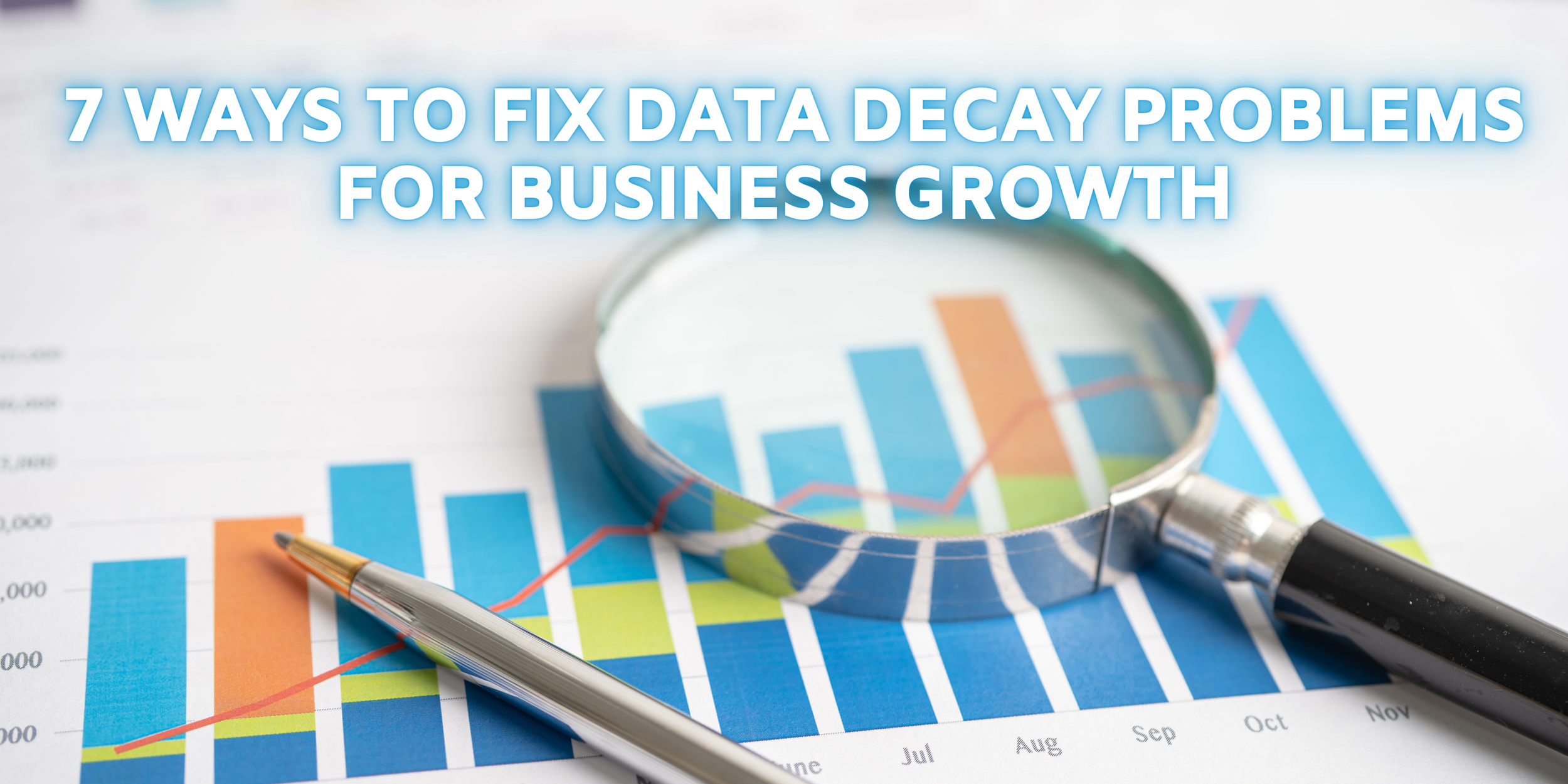Introduction
In business, data decay stands as a daunting challenge, capable of hindering organizational growth and success. At its core, data decay represents the gradual deterioration of information stored within crucial systems like CRM platforms, that have significant impact on sales processes and overall business performance.
Maintaining accurate and up-to-date data in CRM systems is crucial for businesses striving to stay competitive in today's markets. It serves as the bedrock for informed decision-making, effective customer engagement, and personalized sales tactics. As such, recognizing the importance of combating data decay becomes synonymous with safeguarding the vitality and growth potential of any organization.
What is Data Decay?
Data decay, often termed data degradation, is the slow erosion of information stored within your Customer Relationship Management (CRM) system as time progresses. Much like the fading of a photograph or the yellowing of pages in a book over years, data decay manifests in various forms within your database. This degradation is usually made up of outdated email addresses, inaccurate phone numbers, or job titles that have become irrelevant due to personnel changes.
As these details become obsolete, they pose a challenge to the accuracy and reliability of your CRM data, potentially hindering effective communication and decision-making processes within your organization.
Why Data Decay Matters
Data decay poses a significant challenge to businesses, primarily through its adverse effects on resource utilization and lead generation. When email addresses stored in your CRM become outdated, the consequences are measurable through bounced emails, wasted time, and efforts.
In addition, outdated CRM data not only impacts conversion rates but also leads to missed sales opportunities. Inaccurate information undermines the effectiveness of targeted communications, as messages may reach the wrong recipients or fail to capture their attention due to obsolete contact details or job titles. Such discrepancies lower the likelihood of successfully closing deals, ultimately affecting revenue streams.
Futhermore, the result of data decay can result in depersonalization and lower the chance of a a good customer experience. Effective personalization relies on accurate data to provide relevant recommendations and tailored interactions. However, when data becomes outdated, the recommendations offered may no longer align with customers' preferences or needs, resulting in a sense of disconnection and dissatisfaction.
Therefore, leading to a disconnect that can erode customer loyalty and satisfaction, resulting in a negative impact on the overall profitability and success of the business.
Causes of Data Decay
Data decay can stem from various sources, including natural and logical processes. Natural processes involve changes in preferences or contact details, such as email addresses or phone numbers. As individuals transition between jobs, locations, or communication platforms, their contact information can quickly become outdated, leading to data decay.
Moreover, logical processes within databases can contribute to decay. Issues such as duplicate entries, missing fields, or database corruption can render data unreliable or unusable for business stakeholders. These logical inconsistencies not only compromise the integrity of the data but also obstruct decision-making processes and operational efficiency.
Also, the inaccuracies in data input or updates by employees or systems can intensify data decay. Whether due to human error or system glitches, inaccurately entered or updated data can rapidly deteriorate data quality, posing significant challenges for organizations reliant on accurate and up-to-date information.
Overall, combating data decay requires proactive measures to address both natural and logical processes contributing to data deterioration. By implementing strong data management practices and leveraging technology solutions for data validation and cleansing, businesses can mitigate the impacts of data decay and maintain the integrity of their databases for informed decision-making and sustainable growth.
7 Methods to Fix Data Decay Problems
1. Perform Regular Data Cleansing and Validation
Regular data cleansing and validation are crucial steps in maintaining the integrity and accuracy of customer information within databases. This process entails systematically reviewing data to identify any changes or discrepancies, such as outdated contact details or duplicate entries.
By eliminating these inconsistencies and ensuring data accuracy, organizations can cultivate a clean and updated database. This, in turn, facilitates informed decision-making and enhances operational efficiency by providing reliable information for various business processes.
Implementing routine data maintenance practices allows businesses to effectively manage their data assets, supporting strategic initiatives and promoting overall organizational success.
2. Implement Automated Data Verification Tools
Implementing automated data verification tools such as Astera, Data Ladder, and Alteryx optimizes the process of maintaining data accuracy. These tools offer real-time updates and health checks for data, eliminating the need for manual verification and reducing the risk of errors.
By leveraging automation, businesses can ensure data integrity more effectively while saving valuable time and resources. This allows organizations to allocate their resources towards strategic initiatives and focus on driving business growth rather than spending excessive time on manual data management tasks.
3. Enforce Data Maintenance Best Practices
Enforcing data maintenance best practices is crucial for maintaining data consistency and accuracy. This involves implementing real-time updates and data governance policies to ensure that the information remains relevant and reliable.
Establishing data entry standard operating procedures (SOPs) helps stengthen the process and maintain uniformity in data input. By encouraging user feedback fosters a culture of accountability and ensures that data issues are promptly addressed.
Additionally, conducting regular audits and quality checks helps identify and rectify any discrepancies in the data, further enhancing its integrity. By adhering to these best practices, organizations can optimize their data management processes and make more informed business decisions.
4. Integrate Systems for Seamless Data Flow
Integrating systems for seamless data flow is instrumental in optimizing organizational processes. By seamlessly connecting CRM systems with other tools and platforms, businesses can minimize manual cross-checks and modernize workflows. This integration ensures that updates made in one system are promptly reflected across all interconnected platforms, eliminating the risk of data inconsistencies.
Furthermore, fostering a cohesive data ecosystem promotes better collaboration between teams, enabling them to access accurate and up-to-date information for informed decision-making.
Overall, integrating systems enhances operational efficiency and paves the way for more effective business operations.
5. Provide Training and Education for Sales Reps on Data Management
Equipping sales representatives with comprehensive training on data management is essential for fostering a culture of data accuracy and responsibility within the sales team. Through structured training sessions, sales reps can gain insights into the significance of accurate data entry and the critical role of timely updates in maintaining data integrity.
Moreover, these sessions can address common data issues, empowering sales reps to identify and correct discrepancies effectively. By communicating knowledge and skills related to data management, businesses can enhance sales performance and elevate customer satisfaction levels.
Ultimately, investing in the education of sales reps ensures that they are equipped to leverage data effectively in driving successful sales outcomes.
6. Leverage AI and Machine Learning for Data Enrichment
Harnessing the power of artificial intelligence (AI) and machine learning (ML) for data enrichment offers organizations a pathway to unlock valuable insights and enhance their CRM data quality. With custom software solutions such as those offered by ISU Corp, businesses can access real-time updates and predictive analytics capabilities, empowering them to anticipate customer needs and preferences.
By leveraging AI and ML algorithms, organizations can enrich their CRM data with additional information, such as customer behaviour patterns and demographic trends. This enables businesses to gain a deeper understanding of their customer base and tailor their strategies accordingly.
Overall, the integration of AI and ML technologies into data enrichment processes empowers organizations to make data-driven decisions and drive meaningful business outcomes.
7. Promote Collaboration Between Departments
Encouraging collaboration between departments is crucial for combating data decay and achieving sustainable business growth. By fostering an environment where teams share real-time updates and feedback, organizations can leverage the collective expertise of their workforce to maintain data consistency and accuracy.
This collaborative approach helps prevent data silos, ensuring that valuable insights are accessible across the organization. As a result, teams can work together more effectively to identify and address data decay issues, driving better business outcomes and enhancing overall operational efficiency.
Through promoting collaboration and accountability, businesses can create a culture that prioritizes data integrity and supports long-term success.
Futureproofing Your CRM Against Data Decay
Futureproofing your CRM against data decay is essential for ensuring its long-term effectiveness and relevance in driving business success. In today's rapidly changing business environment, customer information is also subject to constant change, organizations must adopt proactive strategies to mitigate the impacts of data decay.
By implementing these robust data management practices, leveraging advanced technologies such as artificial intelligence and machine learning for data enrichment, and fostering a culture of collaboration and accountability across departments business can safeguard their data.
Also by investing in future-proofing measures, businesses can not only maintain the accuracy and integrity of their CRM data but also gain a competitive edge by leveraging actionable insights to drive informed decision-making and enhance customer experiences. As data continues to play a pivotal role in shaping business strategies and driving growth, futureproofing your CRM against data decay is essential for staying ahead in today's marketplace.
Conclusion
In conclusion, the significance of addressing data decay cannot be overstated in today's day and age. As highlighted throughout this discussion, maintaining data accuracy and freshness is crucial for driving business growth and ensuring sustained success. By implementing the seven methods outlined above, organizations can proactively combat data decay and fortify their CRM systems against its detrimental effects. From regular data cleansing and validation to leveraging AI and machine learning for data enrichment, each method offers a strategic approach to safeguarding the integrity of organizational data.
As businesses strive to stay ahead in an increasingly competitive environment, the ability to harness accurate and up-to-date data emerges as a cornerstone of success. Therefore, it is imperative for organizations to prioritize data management practices and embrace a culture of continuous improvement. By doing so, they can unlock the full potential of their CRM systems, drive meaningful customer engagement, and pave the way for sustainable growth and prosperity.
What strategies do you use to fix data decay? let us know in the comments below!
If you are looking for a trusted software development partner to help understand optimize CRM or other software solutions, feel free to contact us. We are a team of experts who can help you design and implement the best custom software solutions.
Written by Natalia Duran
—
ISU Corp is an award-winning software development company, with over 17 years of experience in multiple industries, providing cost-effective custom software development, technology management, and IT outsourcing.
Our unique owners’ mindset reduces development costs and fast-tracks timelines. We help craft the specifications of your project based on your company's needs, to produce the best ROI. Find out why startups, all the way to Fortune 500 companies like General Electric, Heinz, and many others have trusted us with their projects. Contact us here.





















